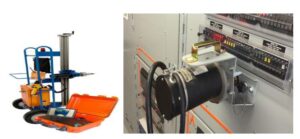Photo source from Matrex power of the isolation website just for display
Introduction about medium voltage switchgear safety:
It is important when operating on medium voltage switchgear that we follow the safety rules and operating regulations in order to be safe. This article covers general safe operations on medium voltage switchgear and looks at the aspects of Switching, Isolating, Testing, and Earthing, as well as various types of Medium Voltage testers and their usage.
There are five types of hazards associated with the operation of medium voltage switchgear:
- Electrical Shock.
- Electrical Burns (for more information please read this article about
- Fire and Explosion.
- Heat Build-Up.
- Mechanical Hazards.
Medium voltage switchgear safety precautions sample list:
A. Personal Protective Equipment (PPE):
- As required in the Code of Safe Practices, always wear the following PPE when working in a potentially unsafe condition.
- Flame resistant (FR) clothing
- Hood
- Smock
- Hand protection
- Eye protection
- Hard hat
- Potentially unsafe situations are described in the Code of Safe Practices.
B. Minimum Safe Working Distance:
- Some enclosures contain energized, high-voltage equipment within easy reach.
- Access enclosures with energized, high-voltage equipment for visual inspection only.
- Maintain a minimum safe working distance from energized equipment as specified in the Code of Safe Practices, Section 809, “Approach and Working Distance.”
- Before unlocking and opening any compartments, treat all equipment in such compartments, as energized, unless and until the equipment has been cleared, high-voltage tested while de-energized, and property grounded.
C. Using Remote Racking Equipment:
- Remote racking devices allow the removal and insertion of metal-clad breakers from an energized bus while the equipment operator is outside of the arc-flash boundary. Remote racking equipment varies as does metal-clad switchgear, so it is critical to understand the specific characteristics of each. Refer to manufacturer’s instructions prior to using remote racking equipment. The manufacturer’s instructions can be found on the Maintenance SharePoint.
CAUTION:
Placing the remote racking device on a cell with a closed breaker can lead to inadvertent tripping of the breaker and damage to the equipment.
You can see a Remote Racking device sample in figure1.

Figure1: Remote Racking device sample
D. Using the Maintenance Slow-Closing Device:
Do not use the maintenance slow-closing device to manually close any circuit breaker energized at its primary voltage. The slow-closing device has insufficient force and speed to ensure safe and proper operation.
E. Precautions for Vacuum Metalclad Switchgear:
Although the maintenance procedures for vacuum metal-clad switchgear are similar to those used for other electrical devices, there are two areas that require extra caution.
- During both normal operation and high-pot tests, the main shield inside an interrupter, as well as other high-voltage parts, can acquire electrical charges. The shield is attached to the external mid-band ring of the insulating bottle. These charges usually remain after the high voltage is removed.
- Remove the charge before touching the interrupter, connections, circuit breaker studs, or bushings by grounding the bushings and grounding the mid-band ring with a clip jumper.
WARNING:
Wear high-voltage rubber gloves and safety glasses when working around vacuum metal-clad switchgear.
X-Ray Radiation for vacuum circuit breaker:
- The high voltage applied across an open gap in a vacuum can produce x-ray radiation.
- The interrupter bottle’s internal shield and the circuit breaker’s metal panels provide a degree of protection.
- During high-pot testing, take one of the following safety precautions to provide sufficient protection from radiation.
- Ensure that the circuit breaker’s metal panels are in place, or Ensure that employees maintain a minimum distance of 3 meters (9 feet, 10 inches) from any exposed interrupter under test.
F. Protection from High Voltage:
- Do not rely on the insulation covering the connectors and bus conductors in metal-clad equipment to provide high-voltage protection to employees.
- Always treat high-voltage equipment as energized, unless it has been tested dead and then grounded.
G. Grounding Bus Sections:
In some indoor stations, cleared bus sections may span several cubicles or floors.
- In cubicles or on floors where grounds are not visible, test the equipment de-energized before working on or near it.
- Install grounds as close to the work location as practical.
- Some situations require multiple ground locations to provide personal protection.
- Ensure that the grounds have been removed from all locations before reporting off and energizing the equipment.
H.Testing Insulation:
Perform and record insulation testing of metal-clad buses and associated equipment:
- When they are installed initially.
- After a bus failure.
- After additions are made to a bus.
- When a questionable insulation condition indicates that it is necessary.
Metalclad Bus Insulation Test:
Isolate the bus by opening all circuit breakers connected to it. If practical, open potential, control-power, and main-power transformer connections, as well.
a.Test phase-to-phase and phase-to-ground with a 2,500 V megger or with a high-pot tester.
b.When tested with a megger, the minimum resistance for metal-clad bus conductors is 10 megohms per line-to-line kV.
Additional Precautions for High-Pot Testing:
Recommended high-pot test voltages vary between manufacturers and may vary between indoor and outdoor types of circuit breakers. To ensure a safe, reliable test, use the test voltages recommended in
the manufacturer’s instructions.
CAUTION:
For all high-voltage insulation testing, ensure that capacitive charges are drained off the equipment both before and after the tests are performed.
I.Ground Knobs:
Some metal-clad switchgear may require the installation of ground knobs for adequate and convenient grounding. These knobs should maintain adequate clearance phase-to-phase and phase-to-ground.
You can find a short video about medium voltage switchgear safety operation:



